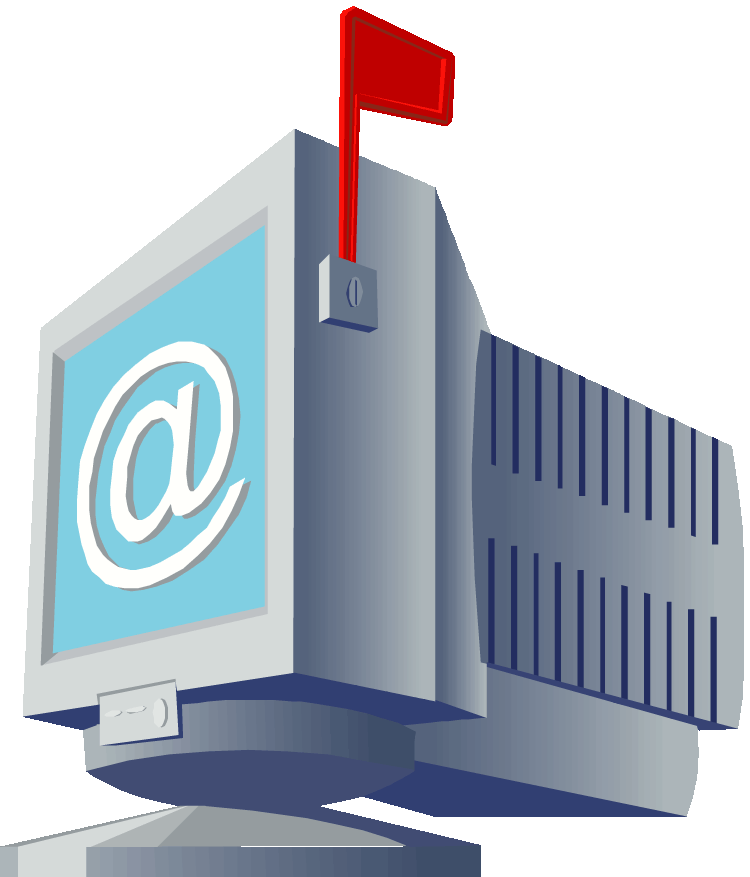
One of the most popular features of the Internet is e-mail. It has become more used than the phone, fax, and "snail mail." Some ISPs offer an e-mail account with your service. Some Web hosting sites also offer e-mail accounts with the site, some allow for a select number of accounts, some offer unlimitied acounts.
E-mail was a driving force in so many people getting on the Internet to communicate with each other. Also, one of the most important features of e-mail is the ability to send files with the messages, which are called attachments. Companies use e-mail messages to keep customers updated on specials and other things going on with the company.
Although e-mail is a great tool on the Web, there are some negative aspects to it. Two of the most known problems are users getting computer viruses from messages and spam, or "junk mail." Computer viruses can come in many forms, and some messages that seem so innocent may be the most likely to have a virus attached. The best way to avoid getting a virus is to only open messages from senders you know, and also to have anti-virus software installed on your computer.

Spam mail, or unsolicitied commercial e-mail, is one of the biggest problems on the Web today. It is estimated that about 98 percent of all e-mail messages are spam, and at one point, it was estimated that billions of spam messages were sent over a 24-hour period. There is not a perfect solution, but there have been many advances that have allowed for control of this "junk mail," as is is often referred to.

There are many different solutions provided now that can prevent or eliminate spam for most users. Some of the different options include:
- Reducing the chance of someone finding out your e-mail address,
- Use multiple addresses,
- Content filtering,
- Legal solutions, and
- Technical solutions.
Two ways in which you can reduce the chance of someone finding out your e-mail address are by making your username more complex and reducing exposure of your e-mail. The only problem is that if you make your username too complex, it may be harder to remember and defeats the purpose of e-mail being a convenient form of communication.
Some people also use more than one e-mail address, each for a different purpose. This can be a good option since you can use one account for personal use, one for shopping, etc. This is a good option since the user can switch e-mails if one gets hacked.
Content filtering is another option, and there are many forms of it. They include basic, advanced, challange-response. Basic content filtering mainly focuses on content found in the e-mail header, particularly the From field. In one method, the filter will look for e-mail addresses that are known to be possible spammers and then place it into a Spam folder. The other method will look for messages that are from senders in the address book. The downside to this is that messages from unknown senders may be considered spam, so this method is often done on an individual basis.
Challange-response content filtering is used with the white-list (the second basic filtering option listed above), and if the message is from a sender not on that list, a message is sent back with a "challange" to make sure the sender is not a spammer. This is not a popular choice since it basically doubles the amount of junk e-mail sent, which would be a huge problem if everyone implemented this filtering method.
One of the most affective, but not completely perfect, advanced spam filtering techniques is the naive Bayesian filter, which basically adapts to what the user decides is spam and what they decide as being legitimate e-mail. This allows for the messages to be filtered by the software's knowledge it gathers from past user choices. There are some drawbacks, but they are easily overshadowed by the amount of time they save in having to sit and delete each message.
In terms of legal solutions, there has only been one piece of legislation passed that has addressed this issue: CAN-SPAM or "Controlling the Assault of Non-Solicited Pornography and Marketing." The main things that are covered include:
- Misleading address header information;
- Deceptive subject headers;
- Clear and conspicuous notice of message nature;
- Physical postal address;
- Mandatory provision of an opt-out mechanism;
- Effectiveness of opt-out mechanism;
- Transfer of e-mail addresses.
Also, there are other things that are not allowed to be done, along with the above. These things include:
- Harvesting e-mail addresses from locations on the Web for the purpose of sending messages.
- Sending messages to e-mail addresses that are generated by multiple means.
- Using scripts to register multiple accounts for the single purpose of spamming.
- Unapproved use of a network to send messages.
- Using someone else's computer to send spam without their permission.
- Misleading e-mail recipients of where a message is sent from.
- Sending messages with false header information.
- Using a fake ID when registering for an e-mail.
- False representation as being an owner of multiple IP addresses for the exclusive purpose of spamming people.
There are few people that believe that this legislation will be effective, but at the same time feel that it is a start at trying to make an impact on spam messaging.